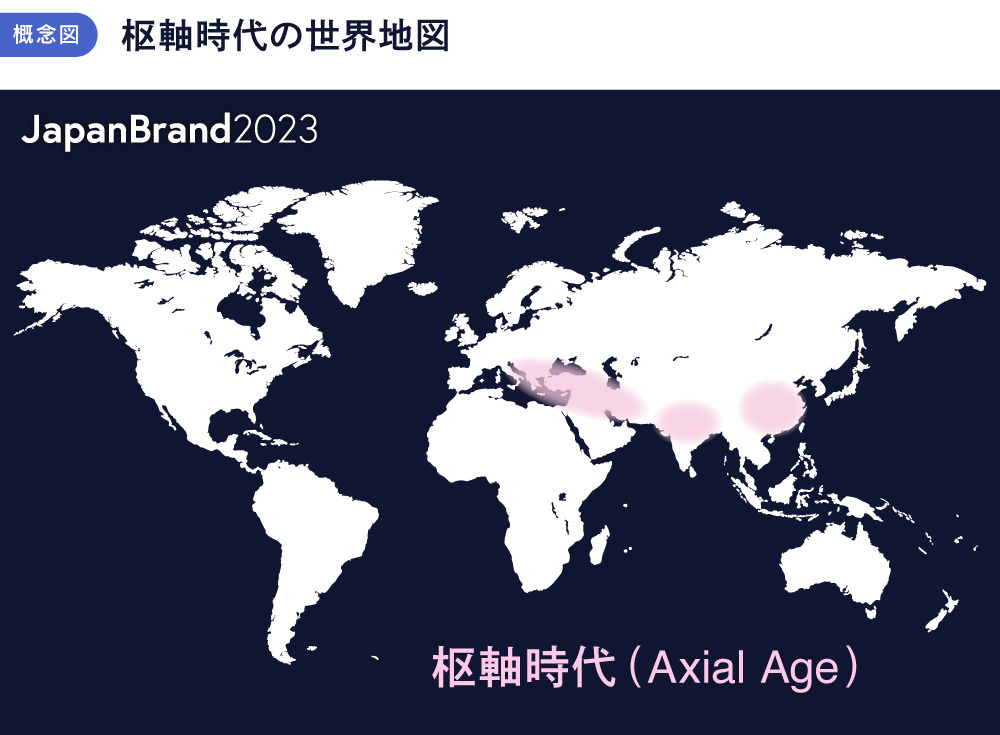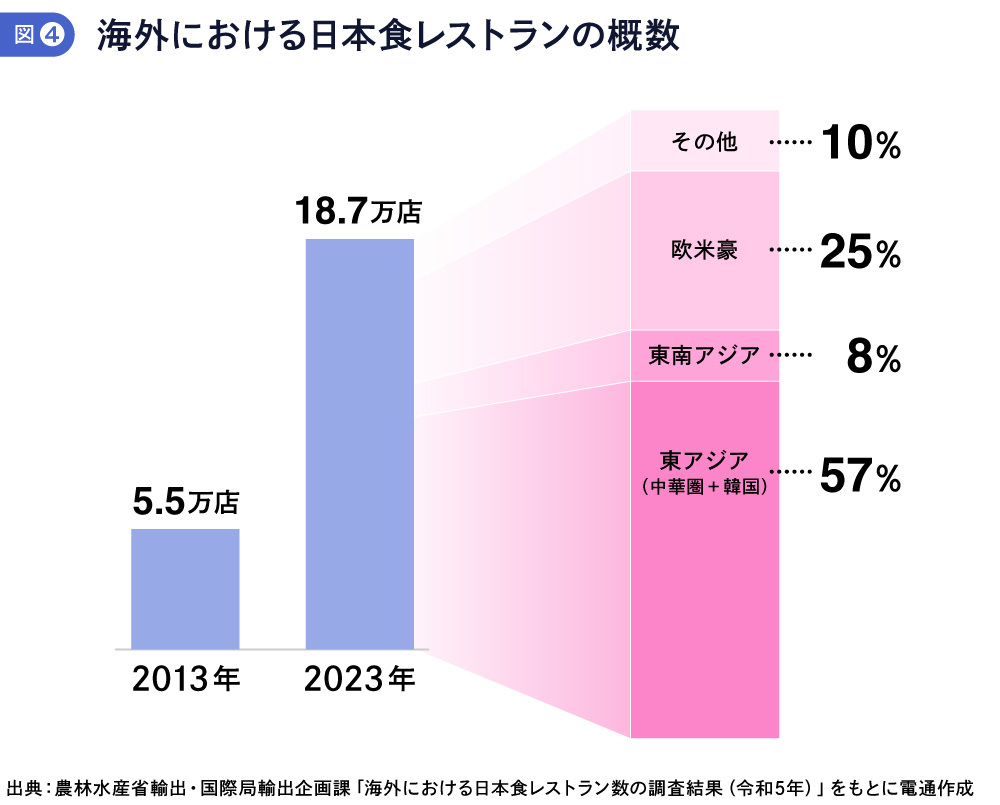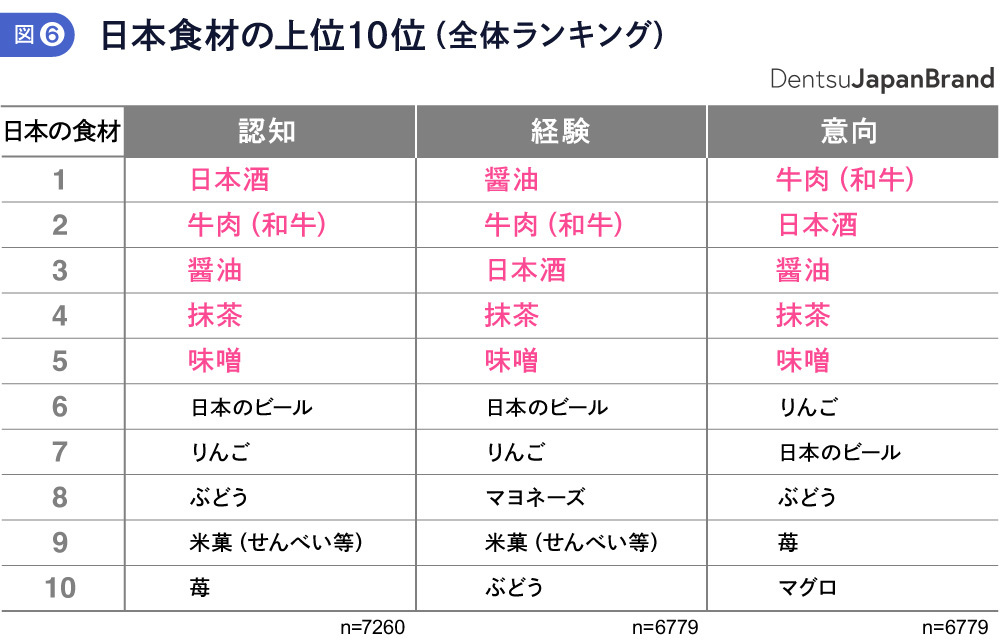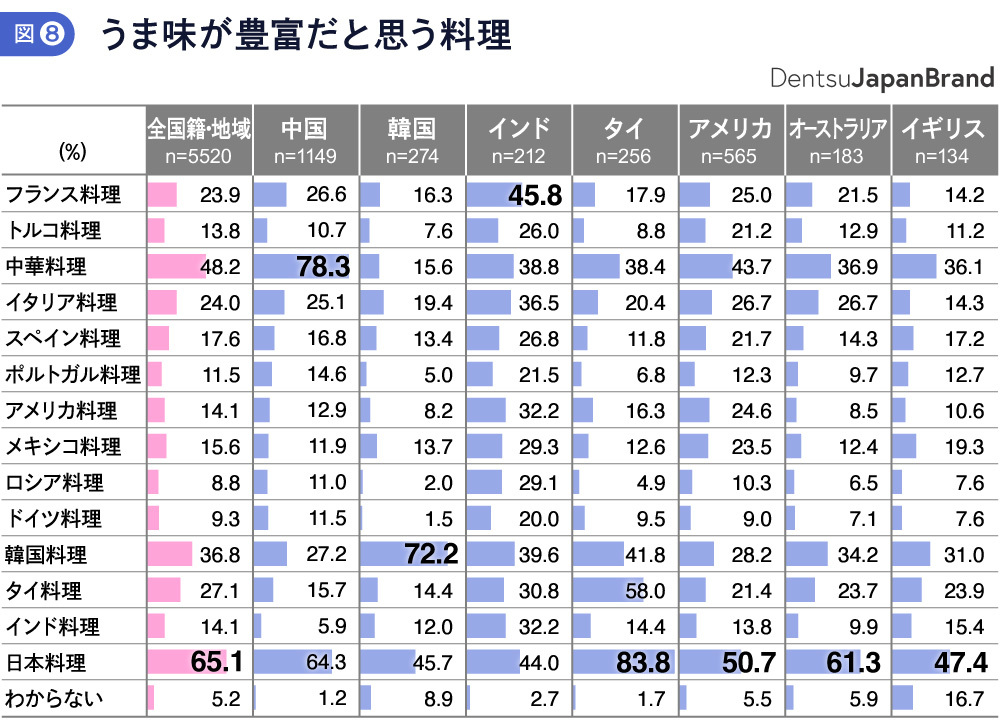Note: This website was automatically translated, so some terms or nuances may not be completely accurate.
Understanding the Significance of Food and Japanese Cuisine Through Connections and Facts
This series examines the current state and future potential of the Japan Brand (including inbound tourism, Japanese food, and Japanese products) using the latest data from Dentsu Inc.'s proprietary "Japan Brand Survey" ( overview here ), targeting middle-to-high-income foreigners living overseas. This installment focuses on "Food."
<Table of Contents>
▼The Unprecedented Connection Between Food and Knowledge
▼Off the Eastern Edge of the Eurasian Continent
▼Global Products: Japanese Cuisine and Japanese Ingredients
▼Three Perspectives on Understanding Umami
▼Food Requires Pairing with Related Fields and Storytelling
The Unfathomable Connections Between Food and Knowledge
Three meals a day. Within this routine, so commonplace it's almost second nature, lie countless grand, untold stories. Over 2,400 years ago, the emergence of the Hundred Schools of Thought in ancient China cannot be discussed without acknowledging the existence of the "shokaku" (guests of the ruling class). These guests were individuals residing in the mansions of powerful figures across the land. As the four-character idiom "three thousand guests" suggests, influential figures reportedly competed over the number of guests they hosted, providing them with food, clothing, and shelter in exchange for their potential as advisors or helpers in times of need. Interpreted today, this resembles a diverse, inclusive job-based organization.
As the saying "When food and clothing are sufficient, one knows propriety" expresses, only after the basic necessity of food is secured can individuals truly engage with their inner selves and talents, allowing them to flourish fully. This blossoming of knowledge occurred not only in China but also in India, ancient Orient (including Persia), and Greece, almost simultaneously. From the 8th to the 3rd century BCE, India saw the birth of Gautama Siddhartha, the founder of Buddhism. In Persia, Zoroastrianism—considered the world's oldest monotheistic religion, founded by Zoroaster—spread widely. It is believed to have later influenced Judaism, Christianity, and Islam. Meanwhile, in ancient Greece, which laid the foundation for today's Western civilization, numerous intellectual giants emerged from Mediterranean civilization, led by the three great philosophers (Socrates, Plato, Aristotle) who built the unshakable foundations of philosophy.
It was in 1949 that Karl Jaspers first proposed defining this era of "contingent proliferation of knowledge," where diverse intellectual traditions blossomed, as the "Axial Age" (※1), a pivotal period in world history. The widespread use of iron drove the development of agriculture. Advances in farming produced sufficient food, which in turn gave birth to diverse forms of knowledge. The Chinese character for "food" (食) combines the characters for "person" (人) and "good" (良). This essence of food—to improve people and enrich the world—remains unchanged throughout history.
※1=Axial Age: The era when the foundational ideas shaping humanity's spiritual landscape emerged. The concept of the Axial Age was proposed by German philosopher and psychiatrist Karl Jaspers.
Off the eastern edge of the Eurasian continent
The sources of knowledge that erupted across the world slowly flowed over time into their respective surrounding regions. Off the eastern edge of the Eurasian continent, Japan transitioned from the Yayoi period to the Kofun period. Chinese Confucianism and Indian Buddhism were transmitted via Baekje (Kudara) and eventually took deep root in Japanese society. Approximately 1,300 years after the introduction of Confucianism and Buddhism, Japan, having swiftly succeeded in modernization by embracing Western civilization, has achieved a unique evolution by creating an unparalleled "accumulative style"—a fusion and coexistence of cultures from all eras and regions. Those who can relativize multiple cultures, customs, and values are likely to find comfort in the appeal of this Japanese accumulative style.
The same holds true for the theme of this article: food. For instance, the ease of finding high-quality, reasonably priced multinational or fusion cuisine within walking distance is also a product of this layered style. Being able to savor the diversity of food readily available nearby, without incurring high financial or time costs, is a truly valuable experience.
Furthermore, Japanese cuisine (washoku), which has enjoyed a long-standing international boom, is a prime example beautifully expressing this layered worldview. Exactly ten years ago, washoku was inscribed on UNESCO's Intangible Cultural Heritage list (Washoku; Traditional Japanese Cuisine, 2013). The characteristics of Washoku include: "① Respect for diverse, fresh ingredients and their inherent flavors, ② Nutritional balance supporting a healthy diet, ③ Expression of natural beauty and the changing seasons, ④ Close connection to annual events like New Year's" (※2). In other words, it embodies a distinctly Japanese concept: seeking not merely taste, but also considering multifaceted elements surrounding food to achieve a higher level of harmony.
※2 The four characteristics of Washoku are quoted from the Ministry of Agriculture, Forestry and Fisheries' food culture portal site. Source: Ministry of Agriculture, Forestry and Fisheries "Washoku" Registered as UNESCO Intangible Cultural Heritagehttps://www.maff.go.jp/j/keikaku/syokubunka/ich/index.html
Incidentally, simply referring to "Japanese food" in general terms makes it difficult to grasp the true nature of the boom without examining it by genre or specific items. The Dentsu Inc. Japan Brand Survey conducted large-scale research separately on Japanese cuisine (9 categories, 42 types) and Japanese ingredients (9 categories, 54 items). Based on these results, we explored the reality of the Japanese food boom.
Global Products of "Japanese Cuisine" and "Japanese Ingredients"
First, let's briefly grasp the trends in popular Japanese cuisine.
Ranking within the top 10 for all three indicators of "Awareness, Consumption Experience, and Consumption Intention" for Japanese cuisine were: "High-end Sushi," "Ramen," "Tempura," "Fried Shrimp," "Onigiri (Rice Balls)," "Tofu," "Miso Soup," "Sashimi," "Karaage (Fried Chicken)," and "Udon." All of these can be considered globally recognized Japanese dishes.
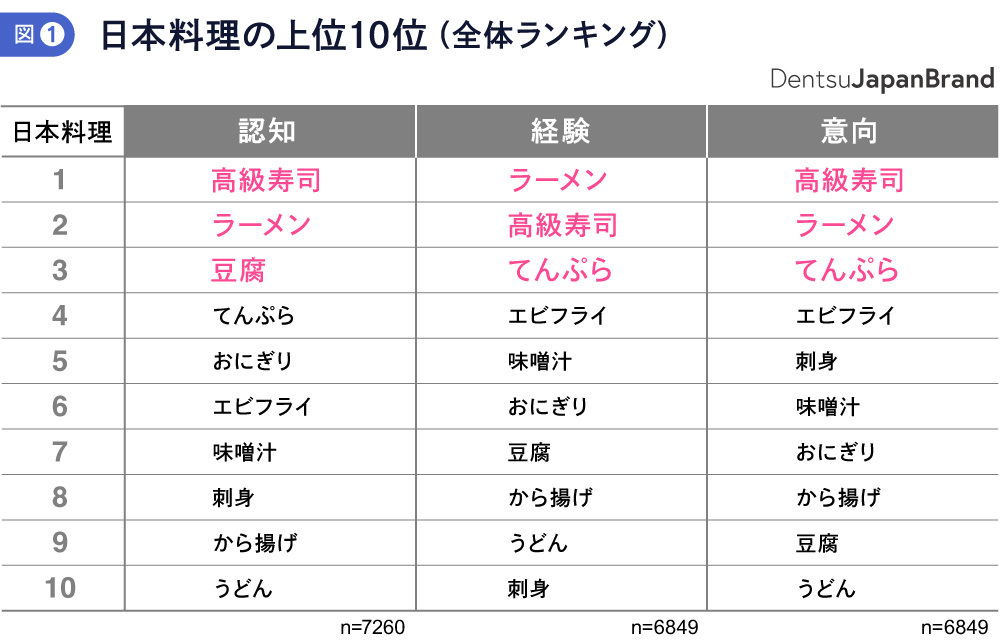
Furthermore, when viewed from the perspective of Japan visit experience, repeat visitors (those who have visited Japan 3 or more times) show a noticeable increase in the consumption rates of "gyudon," "tonkatsu," and "unagi." Particularly for unagi consumption, the rate among repeat visitors (30.3%) is over 20 percentage points higher than among those who have never visited Japan (8.0%), and significantly exceeds the overall average (17.3%). Although not ranking within the top 10, similar trends were observed for sukiyaki and kaiseki cuisine.
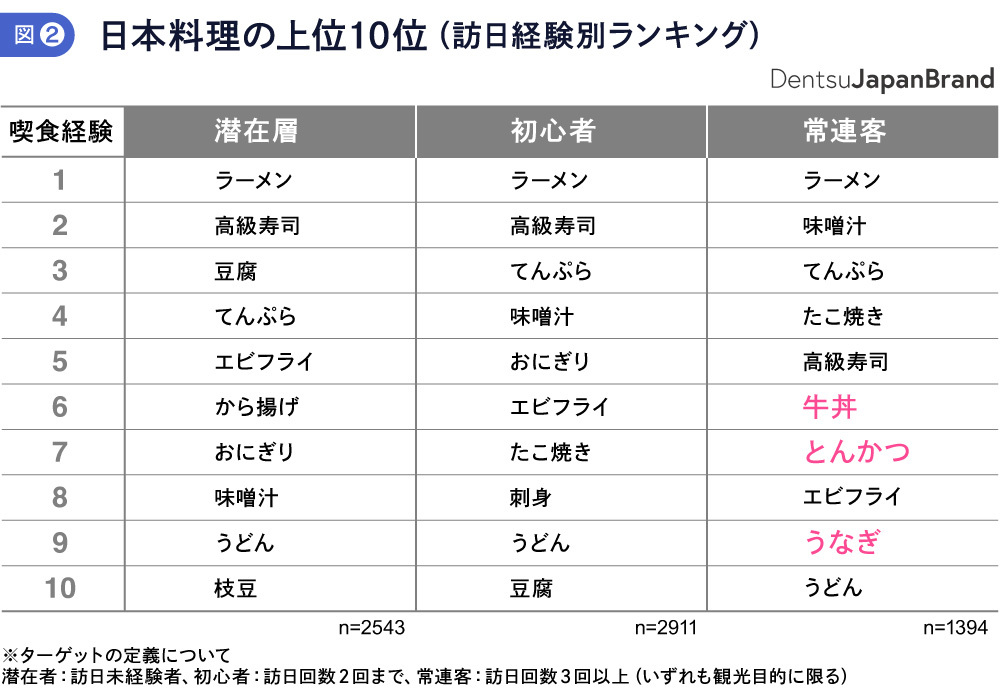
Next, we'll explore the image of Japanese ingredients from an overseas perspective, along with Japanese ingredients that can be considered global products, by excerpting just a small portion of the vast survey data on Japanese ingredients.
Safe, high-quality, delicious... Do overseas consumers share the image Japanese people have of ingredients made in Japan? When looking at the global picture, we want you to remember "Delicious, Fresh, High Quality" as the most important keywords. These three attributes stand out significantly above others, ranking at the top. It's no exaggeration to say they represent the highest possible level of image evaluation for ingredients.
However, looking at individual regions, the variation in perception is significant. While Southeast Asia and Europe/America/Australia show relatively strong perceptions of the aforementioned "Beauty, Freshness, Quality," East Asia shows a generally flat profile, suggesting no particularly dominant image.
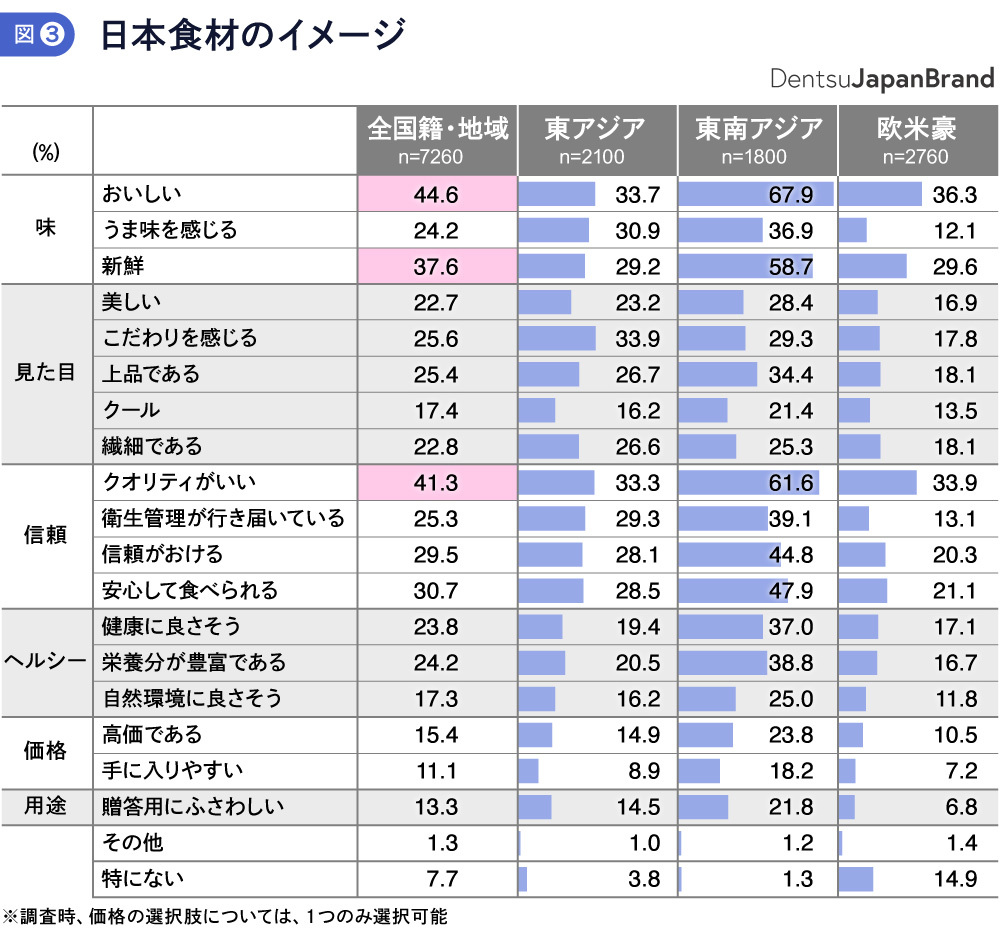
Since the 2010s, the number of Japanese restaurants overseas has surged dramatically. According to the Ministry of Agriculture, Forestry and Fisheries survey "Number of Japanese Restaurants Overseas (※Figure 4)," the number of Japanese restaurants in 2023 (approximately 187,000) increased by about 3.4 times compared to 2013 (approximately 55,000). Breaking this down reveals that approximately 57% of Japanese cuisine establishments are concentrated in East Asia. In other words, compared to Europe, America, Australia, and Southeast Asia, consumers in East Asia have more frequent, accessible opportunities to experience Japanese cuisine. This likely fosters a more multifaceted understanding of Japanese cuisine, leading to a diversification and broadening of its image. While East Asia is a leading region for Japanese cuisine, it is also viewed as a highly VUCA society where fierce competition unfolds. In this sense, striking a balance between three elements becomes imperative: Japanese identity, the sense of self derived from that identity, and survival of the fittest.
Having covered the general image of Japanese ingredients, let's now look at popular ingredients by region.
In the geographically and culturally close East Asian market, "beef (Wagyu)" and "sake" command overwhelming presence. In the fruit category, "apples," "grapes," and "strawberries" are popular. In the alcoholic beverages category, while not yet matching sake, "shochu/awamori" and "Japanese beer" are recognized, showing relatively high drinking/purchase intent.
In the Europe, America, and Australia markets, data reveals that "beef (Wagyu)" and "sake" are popular Japanese ingredients, and "soy sauce" is also extremely popular. In all metrics, Australia and European countries significantly exceed the global average.
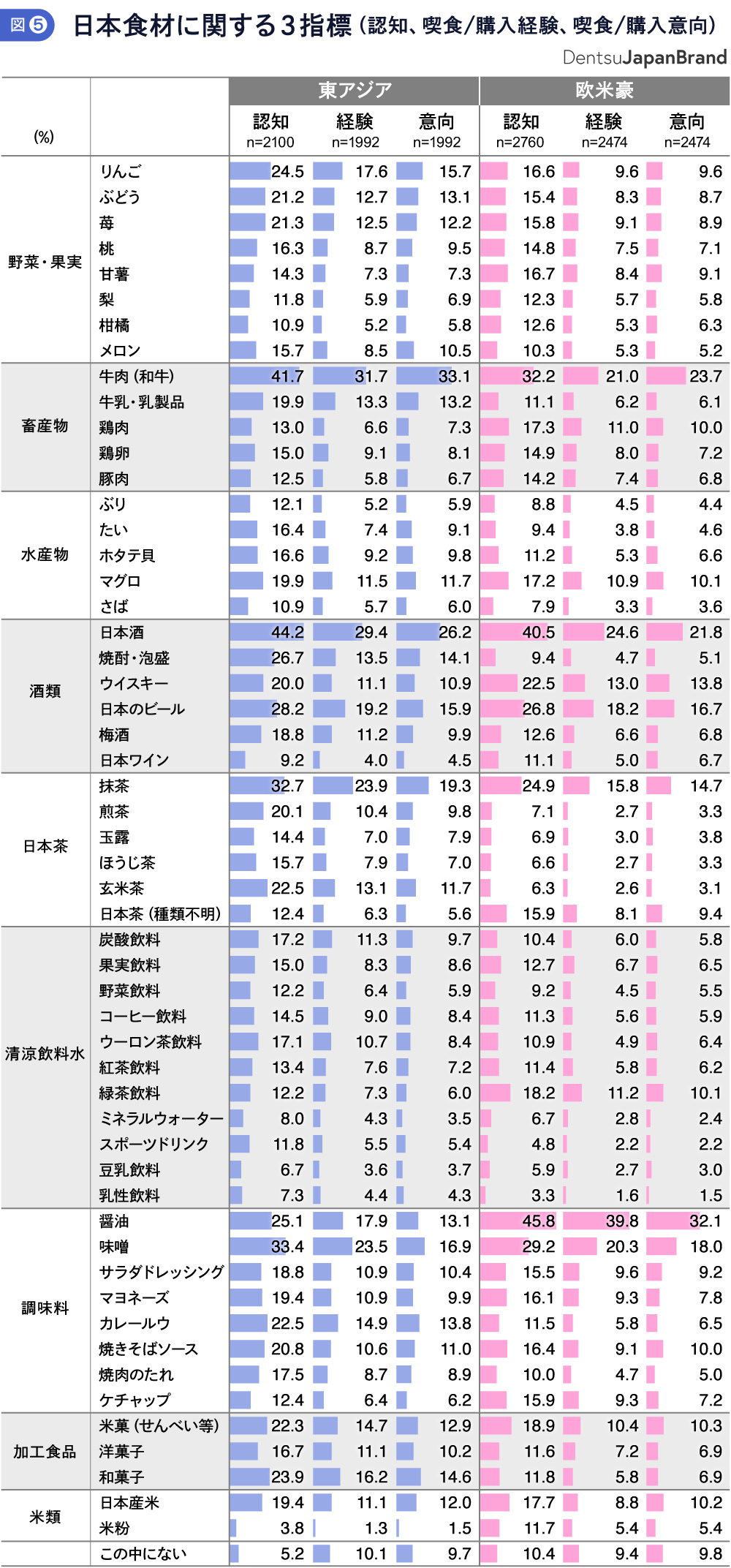
Thus, while some Japanese ingredients are universally favored across regions, there are also distinct popular items unique to each market. Globally, the top five items across all three indicators—awareness, consumption/purchase experience, and consumption/purchase intent—are "Japanese sake," "beef (Wagyu)," "soy sauce," "matcha," and "miso." These can be considered global commodities within the food ingredient category.
Understanding umami varies from person to person
This article concludes with a look at "umami," one of the great Japanese assets discovered by our predecessors.
Umami is one of the five basic tastes and an indispensable element when discussing Japanese cuisine. Discovered over a century ago, umami is now recognized worldwide as a common noun, retained in its Japanese form in English (as well as French, German, Italian, etc.).
However, umami is not as universally understood or easily recognizable as tastes like sweetness, sourness, saltiness, or bitterness. Based on the hypothesis that the concept of umami and its relationship to food are not necessarily perceived the same way as by Japanese people, Dentsu Inc. Japan's Brand Survey examined the level of understanding of umami by country and region.
Overall, about 40% of respondents knew that "umami is one of the five basic tastes alongside sweetness, sourness, saltiness, and bitterness" and that "it significantly contributes to the deliciousness of food." However, when viewed by country and region, the percentage ranged from as low as 20-30% in some countries to over 50% in others, showing significant variation. Surprisingly, nearly 20% of respondents overall were completely unaware of umami itself. In Canada, the UK, and France, this proportion exceeds 40%.
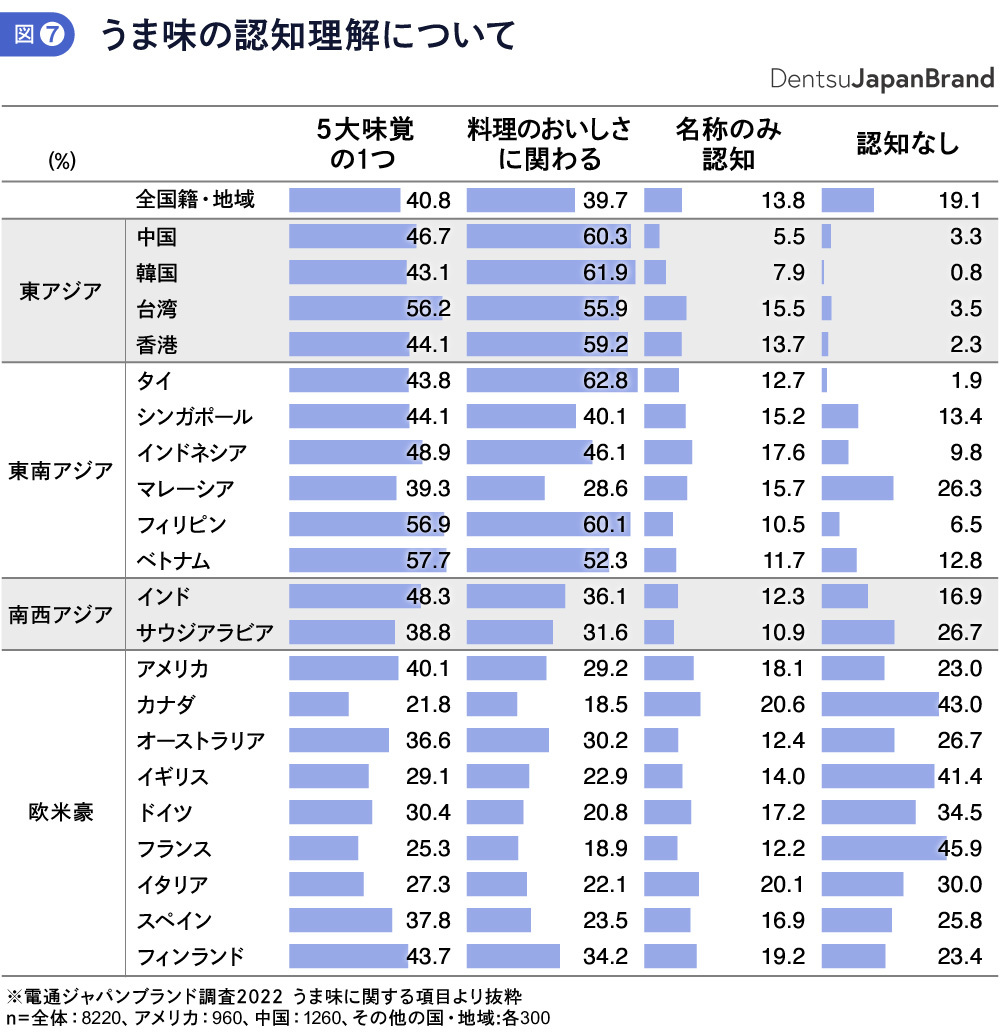
Furthermore, an analysis of how much variation exists in the understanding of which cuisine genres contain the most umami across countries yielded interesting results.
In China (1st in number of Japanese restaurants) and South Korea (3rd in number of Japanese restaurants), an overwhelming majority of respondents believe their own cuisine is the richest in umami. In India, a member of the Global South receiving significant attention, French cuisine and Japanese cuisine are ranked almost equally as rich in umami. Slightly below these two genres are Korean cuisine, Chinese cuisine, and Italian cuisine, indicating that Japanese cuisine's superiority in umami is not particularly outstanding.
Food requires pairing with peripheral elements and storytelling as essential requirements
In recent years, tourism themes have diversified and fragmented, leading to the development of various forms of tourism such as adventure tourism, sustainable tourism, and gastronomic tourism. Among these, excluding the United States, gastronomic tourism has the highest participation intent. Furthermore, according to a Japan Tourism Agency survey, spending on the food and beverage category accounts for over 20% of total spending (※3). This survey also revealed that food is a category where people are willing to spend money actively.
※3 Ministry of Land, Infrastructure, Transport and Tourism, Japan Tourism Agency: Survey on Consumption Trends of Inbound Tourists <January-March 2023, April-June 2023, July-September 2023 (Preliminary Figures), Full Year 2019 (Final Figures)>
https://www.mlit.go.jp/kankocho/siryou/toukei/syouhityousa.html
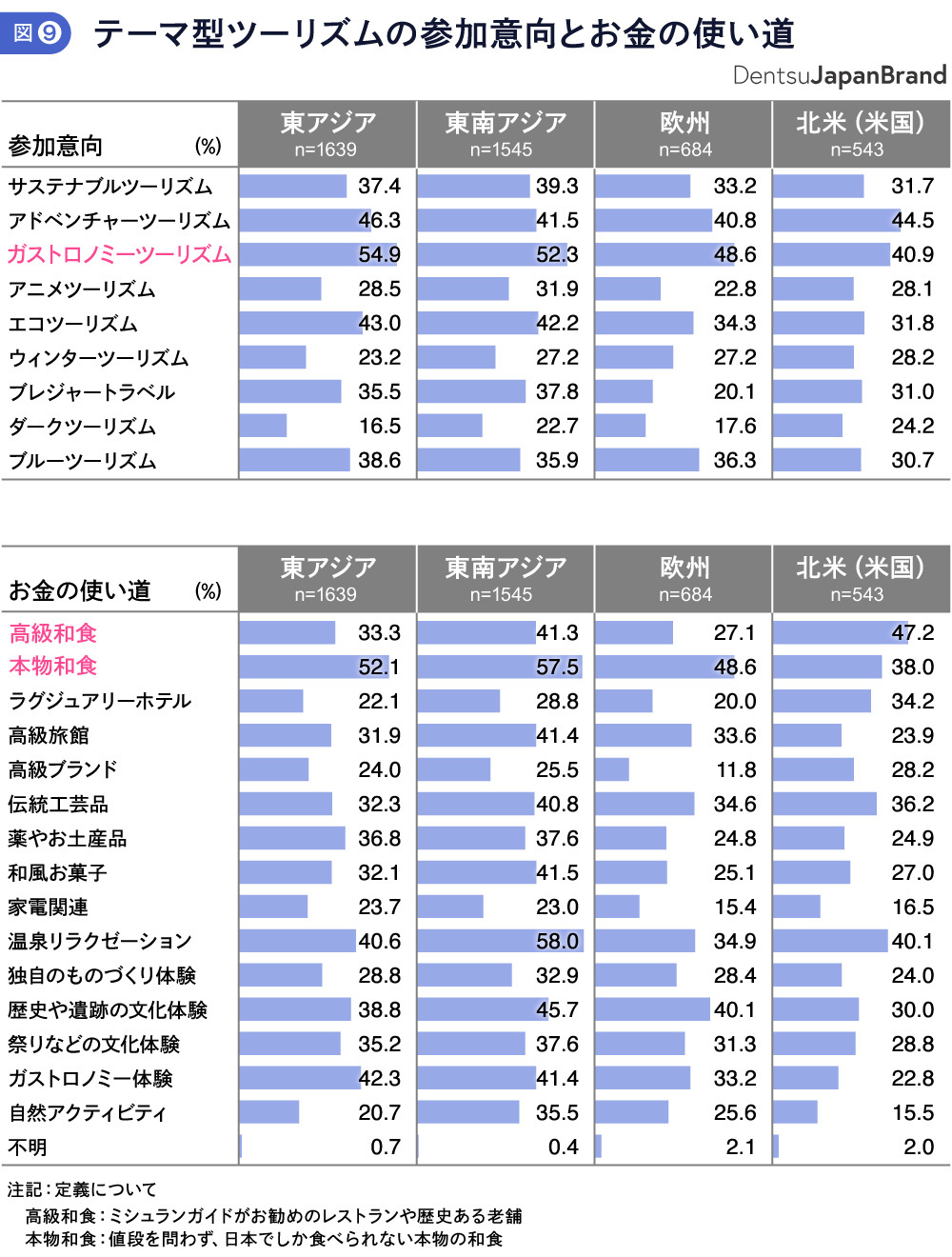
Furthermore, 7 out of 10 respondents stated that they "prefer to savor dishes after learning about the underlying knowledge such as ingredients, tableware, and cooking methods," and that "understanding the history and brand story of products or companies definitely increases their desire to purchase." In other words, it is appropriate to view food initiatives not merely as the act of eating, but as an integrated whole that involves developing peripheral fields such as crafts, fine arts, art, spatial design, history, culture, and philosophy (holistic experience design). These peripheral fields should no longer be considered "nice to have," but rather "essential."

As already indicated in the latest Basic Plan for Promoting Tourism as a National Strategy, inbound tourism is a broad-based industry that not only generates foreign exchange but also significantly contributes to international mutual understanding and peace (※4). Meanwhile, "food that enriches people and the world" is a category highly compatible with both inbound tourism and overseas exports. Just as food and knowledge have been profoundly interconnected throughout history, supporting global civilization and societal progress, they will undoubtedly continue to play an unchanging positive role in the future.
※4 Ministry of Land, Infrastructure, Transport and Tourism, Japan Tourism Agency: "Outline of the Basic Plan for the Promotion of Tourism Nation (4th)"
https://www.mlit.go.jp/kankocho/kankorikkoku/kihonkeikaku.html
In practical business operations, whether refining gastronomic tourism or promoting exports of Japanese ingredients and cuisine, it will be increasingly essential not only to enhance the resolution of "Japanese food" as understood by foreign consumers but also to develop diverse pairings with related fields and storytelling that conveys a depth and richness unattainable elsewhere.
※Country and region names in this article are written for Japanese readers and follow Japanese social norms and business practices.
【Contact for Inquiries Regarding This Matter】
Dentsu Inc. Japan Brand Research Project Office
japanbrand@dentsu.co.jp
【About the Dentsu Inc. Japan Brand Survey】
2011年、東日本大震災で日本の農水産物や訪日旅行に風評被害が発生した際に、Dentsu Inc.が独自に実施した調査。
【Dentsu Inc. Japan Brand Survey 2023 Overview】
・Target Areas: 19 countries/regions (United States, China, South Korea, Taiwan, Hong Kong, Singapore, Thailand, Malaysia, Indonesia, Vietnam, Philippines, India, Australia, Saudi Arabia, United Kingdom, France, Germany, Italy, Spain)
・Respondent Criteria: Middle-to-high income individuals, men and women aged 20s to 50s
・Sample Size: 7,260 people (USA = 960, China = 1,200, Other countries/regions = 300 each). Samples were collected with equal allocation by gender and age group for each country/region, then weighted to match population proportions.
・Survey Method: Online survey
・Survey Period: December 2022 - January 2023
・Research Agency: Video Research Ltd.
【Dentsu Inc. Japan Brand Survey 2022 Overview】
・Target Areas: 22 countries/regions (United States, Canada, China, South Korea, Taiwan, Hong Kong, Singapore, Thailand, Malaysia, Indonesia, Vietnam, Philippines, India, Australia, Saudi Arabia, United Kingdom, France, Germany, Italy, Spain, Russia, Finland)
・Respondent Criteria: Middle- to high-income individuals, men and women aged 20s to 50s
・Sample Size: 8,220 people (United States = 960, China = 1,260, Other countries/regions = 300 each) Samples were collected with equal allocation by gender and age group for each country/region, and weighted back to match the population composition
・Survey Method: Online survey
・Survey period: December 2021 to January 2022
・Research Institution: Video Research Ltd.
Was this article helpful?
Newsletter registration is here
We select and publish important news every day
For inquiries about this article
Author

Li Shunshi
Dentsu Inc.
First Business Transformation Bureau
Planner, Producer
Guided by the mottos "Everything flows" and "A blessing in disguise," I engage in diverse projects while transcending specializations in marketing, research, media, global operations, and project management.
